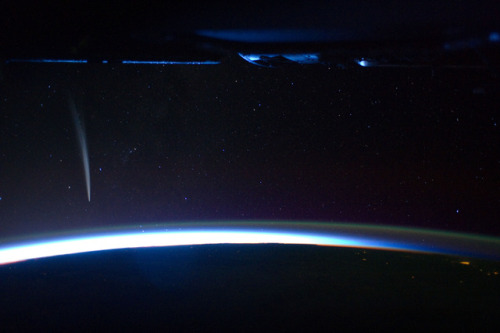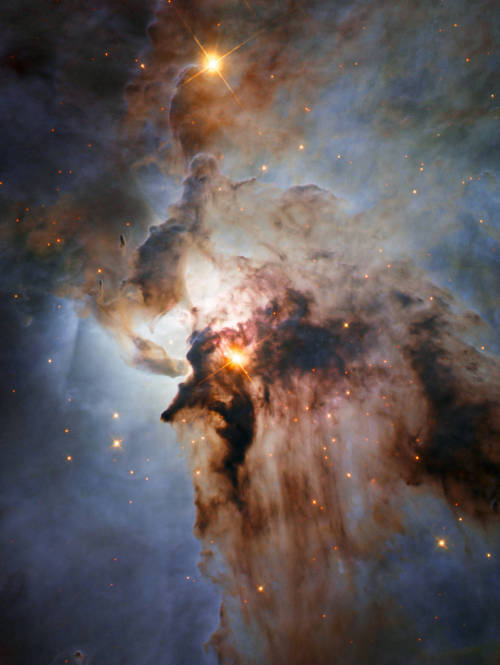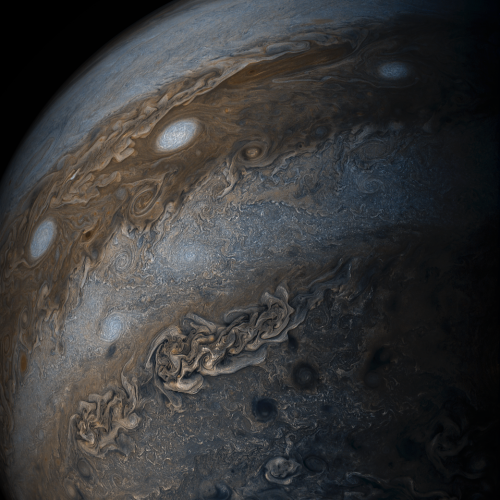Meteor Impact Craters Of The World

Meteor impact craters of the world
More Posts from Xyhor-astronomy and Others

Massive Stars in Open Cluster Pismis 24
How massive can a normal star be? Estimates made from distance, brightness and standard solar models had given one star in the open cluster Pismis 24 over 200 times the mass of our Sun, making it a record holder. This star is the brightest object located just above the gas front in the above image. Close inspection of images taken recently with the Hubble Space Telescope, however, have shown that Pismis 24-1 derives its brilliant luminosity not from a single star but from three at least. Component stars would still remain near 100 solar masses, making them among the more massive stars currently on record. Toward the bottom of the image, stars are still forming in the associated emission nebula NGC 6357, including several that appear to be breaking out and illuminating a spectacular cocoon.
Credit: NASA, ESA and J. M. Apellániz (IAA, Spain)

Shadow Veil by Abi Ashra (Tumblr)

Curiosity drill site reveals that under its red surface, Mars is grey-blue
via reddit

Comet Lovejoy is visible near Earth’s horizon in this nighttime image photographed by NASA astronaut Dan Burbank, Expedition 30 commander, onboard the International Space Station on Dec. 21, 2011.
Image credit: NASA

Stormy Seas in Sagittarius
This new NASA/ESA Hubble Space Telescope image shows the center of the Lagoon Nebula, an object with a deceptively tranquil name, in the constellation of Sagittarius. The region is filled with intense winds from hot stars, churning funnels of gas, and energetic star formation, all embedded within an intricate haze of gas and pitch-dark dust.
Image Credit: NASA/JPL/ESA/J. Trauger
A Hitchhiker’s Ride to Space
This month, we are set to launch the latest weather satellite from the National Oceanic and Atmospheric Administration (NOAA). The Joint Polar Satellite System-1, or JPSS-1, satellite will provide essential data for timely and accurate weather forecasts and for tracking environmental events such as forest fires and droughts.

Image Credit: Ball Aerospace
JPSS-1 is the primary satellite launching, but four tiny satellites will also be hitchhiking a ride into Earth orbit. These shoebox-sized satellites (part of our CubeSat Launch Initiative) were developed in partnership with university students and used for education, research and development. Here are 4 reasons why MiRaTA, one of the hitchhikers, is particularly interesting…

Miniaturized Weather Satellite Technology
The Microwave Radiometer Technology Acceleration (MiRaTA) CubeSat is set to orbit the Earth to prove that a small satellite can advance the technology necessary to reduce the cost and size of future weather satellites. At less than 10 pounds, these nanosatellites are faster and more cost-effective to build and launch since they have been constructed by Principal Investigator Kerri Cahoy’s students at MIT Lincoln Laboratory (with lots of help). There’s even a chance it could be put into operation with forecasters.

The Antenna? It’s a Measuring Tape
That long skinny piece coming out of the bottom right side under MiRaTA’s solar panel? That’s a measuring tape. It’s doubling as a communications antenna. MiRaTA will measure temperature, water vapor and cloud ice in Earth’s atmosphere. These measurements are used to track major storms, including hurricanes, as well as everyday weather. If this test flight is successful, the new, smaller technology will likely be incorporated into future weather satellites – part of our national infrastructure.

Tiny Package Packing a Punch MiRaTA will also test a new technique using radio signals received from GPS satellites in a higher orbit. They will be used to measure the temperature of the same volume of atmosphere that the radiometer is viewing. The GPS satellite measurement can then be used for calibrating the radiometer. “In physics class, you learn that a pencil submerged in water looks like it’s broken in half because light bends differently in the water than in the air,” Principal Investigator Kerri Cahoy said. “Radio waves are like light in that they refract when they go through changing densities of air, and we can use the magnitude of the refraction to calculate the temperature of the surrounding atmosphere with near-perfect accuracy and use this to calibrate a radiometer.”

What’s Next?
In the best-case scenario, three weeks after launch MiRaTA will be fully operational, and within three months the team will have obtained enough data to study if this technology concept is working. The big goal for the mission—declaring the technology demonstration a success—would be confirmed a bit farther down the road, at least half a year away, following the data analysis. If MiRaTA’s technology validation is successful, Cahoy said she envisions an eventual constellation of these CubeSats orbiting the entire Earth, taking snapshots of the atmosphere and weather every 15 minutes—frequent enough to track storms, from blizzards to hurricanes, in real time.
Learn more about MiRaTA
Watch the launch!

The mission is scheduled to launch this month (no sooner than Nov. 14), with JPSS-1 atop a United Launch Alliance (ULA) Delta II rocket lifting off from Space Launch Complex 2 at Vandenberg Air Force Base in California. You’ll be able to watch on NASA TV or at nasa.gov/live.

Watch the launch live HERE on Nov. 14, liftoff is scheduled for Tuesday, 4:47 a.m.!
Make sure to follow us on Tumblr for your regular dose of space: http://nasa.tumblr.com.







10 Spacetime Mysteries That Quantum Gravity Could Solve
“4.) In most approaches to quantum gravity, space-time is not fundamental but made of something else. That might be strings, loops, qbits, or some variant of space-time “atoms” which appear in condensed-matter based approaches. The individual constituents, however, can only be resolved when probed with extremely high energies, far beyond what we can achieve on Earth.”
What is the fundamental nature of the Universe? When it comes to General Relativity, our answer is matter and energy on one hand, and spacetime on the other. But there’s another side to that story: a quantum one. While matter and energy can be discretized into quanta, our notion of spacetime is purely classical. But depending on what our true, fundamental theory of quantum gravity actually is, it could have incredible implications for our Universe. Perhaps we have tiny little black holes popping in and out of existence on a continuous basis; perhaps the vacuum of space isn’t entirely transparent to light; perhaps time turns into space at some level; perhaps wormholes and baby Universes are real. These are mysteries that are currently unresolved, but quantum gravity could provide the answer.
What are the mysteries, and what does it all mean? Sabine Hossenfelder explores, with a fantastic video!

Jupiter’s Bands of Clouds
This enhanced-color image of Jupiter’s bands of light and dark clouds was created by citizen scientists Gerald Eichstädt and Seán Doran using data from the JunoCam imager on NASA’s Juno spacecraft.
Three of the white oval storms known as the “String of Pearls” are visible near the top of the image. Each of the alternating light and dark atmospheric bands in this image is wider than Earth, and each rages around Jupiter at hundreds of miles (kilometers) per hour. The lighter areas are regions where gas is rising, and the darker bands are regions where gas is sinking.
Credits: NASA/JPL-Caltech/SwRI/MSSS/Gerald Eichstädt /Seán Doran

An irregular island
This image, courtesy of the NASA/ESA Hubble Space Telescope’s Advanced Camera for Surveys (ACS), captures the glow of distant stars within NGC 5264, a dwarf galaxy located just over 15 million light-years away in the constellation of Hydra (The Sea Serpent).
Dwarf galaxies like NGC 5264 typically possess around a billion stars — just one per cent of the number of stars found within the Milky Way. They are usually found orbiting other, larger, galaxies such as our own, and are thought to form from the material left over from the messy formation of their larger cosmic relatives.
NGC 5264 clearly possesses an irregular shape — unlike the more common spiral or elliptical galaxies — with knots of blue star formation. Astronomers believe that this is due to the gravitational interactions between NGC 5264 and other galaxies nearby. These past flirtations sparked the formation of new generations of stars, which now glow in bright shades of blue.
https://www.spacetelescope.org/images/potw

Hubble peeks inside a stellar cloud
These bright stars shining through what looks like a haze in the night sky are part of a young stellar grouping in one of the largest known star formation regions of the Large Magellanic Cloud (LMC), a dwarf satellite galaxy of the Milky Way. The image was captured by the NASA/ESA Hubble Space Telescope’s Wide Field Planetary Camera 2.
The stellar grouping is known to stargazers as NGC 2040 or LH 88. It is essentially a very loose star cluster whose stars have a common origin and are drifting together through space. There are three different types of stellar associations defined by their stellar properties. NGC 2040 is an OB association, a grouping that usually contains 10–100 stars of type O and B — these are high-mass stars that have short but brilliant lives. It is thought that most of the stars in the Milky Way were born in OB associations.
There are several such groupings of stars in the LMC, including one previously featured as a Hubble Picture of the Week. Just like the others, LH 88 consists of several high-mass young stars in a large nebula of partially ionised hydrogen gas, and lies in what is known to be a supergiant shell of gas called LMC 4.
Over a period of several million years, thousands of stars may form in these supergiant shells, which are the largest interstellar structures in galaxies. The shells themselves are believed to have been created by strong stellar winds and clustered supernova explosions of massive stars that blow away surrounding dust and gas, and in turn trigger further episodes of star formation.
The LMC is the third closest galaxy to our Milky Way. It is located some 160 000 light-years away, and is about 100 times smaller than our own.
This image, which shows ultraviolet, visible and infrared light, covers a field of view of approximately 1.8 by 1.8 arcminutes.
A version of this image was entered into the Hubble’s Hidden Treasures Image Processing Competition by contestant Eedresha Sturdivant. Hidden Treasures is an initiative to invite astronomy enthusiasts to search the Hubble archive for stunning images that have never been seen by the general public.
These bright stars shining through what looks like a haze in the night sky are part of a young stellar grouping in one of the largest known star formation regions of the Large Magellanic Cloud (LMC), a dwarf satellite galaxy of the Milky Way. The image was captured by the NASA/ESA Hubble Space Telescope’s Wide Field Planetary Camera 2.
The stellar grouping is known to stargazers as NGC 2040 or LH 88. It is essentially a very loose star cluster whose stars have a common origin and are drifting together through space. There are three different types of stellar associations defined by their stellar properties. NGC 2040 is an OB association, a grouping that usually contains 10–100 stars of type O and B — these are high-mass stars that have short but brilliant lives. It is thought that most of the stars in the Milky Way were born in OB associations.
There are several such groupings of stars in the LMC, including one previously featured as a Hubble Picture of the Week. Just like the others, LH 88 consists of several high-mass young stars in a large nebula of partially ionised hydrogen gas, and lies in what is known to be a supergiant shell of gas called LMC 4.
Over a period of several million years, thousands of stars may form in these supergiant shells, which are the largest interstellar structures in galaxies. The shells themselves are believed to have been created by strong stellar winds and clustered supernova explosions of massive stars that blow away surrounding dust and gas, and in turn trigger further episodes of star formation.
The LMC is the third closest galaxy to our Milky Way. It is located some 160 000 light-years away, and is about 100 times smaller than our own.
This image, which shows ultraviolet, visible and infrared light, covers a field of view of approximately 1.8 by 1.8 arcminutes.
A version of this image was entered into the Hubble’s Hidden Treasures Image Processing Competition by contestant Eedresha Sturdivant. Hidden Treasures is an initiative to invite astronomy enthusiasts to search the Hubble archive for stunning images that have never been seen by the general public.
ESA/Hubble, NASA and D. A Gouliermis. Acknowledgement: Flickr user Eedresha Sturdivant
https://www.spacetelescope.org/images/potw
-
 herestheplan reblogged this · 6 years ago
herestheplan reblogged this · 6 years ago -
 herestheplan liked this · 6 years ago
herestheplan liked this · 6 years ago -
 d--r--i--f--t--w--o--o--d reblogged this · 6 years ago
d--r--i--f--t--w--o--o--d reblogged this · 6 years ago -
 xyhor-physicalgeography reblogged this · 7 years ago
xyhor-physicalgeography reblogged this · 7 years ago -
 cristinh reblogged this · 7 years ago
cristinh reblogged this · 7 years ago -
 gazolli reblogged this · 7 years ago
gazolli reblogged this · 7 years ago -
 gazolli reblogged this · 7 years ago
gazolli reblogged this · 7 years ago -
 spatialisspecial reblogged this · 7 years ago
spatialisspecial reblogged this · 7 years ago -
 punfunandcoolstuff reblogged this · 7 years ago
punfunandcoolstuff reblogged this · 7 years ago -
 verhaal140 liked this · 7 years ago
verhaal140 liked this · 7 years ago -
 ryan-nary liked this · 7 years ago
ryan-nary liked this · 7 years ago -
 pstt liked this · 7 years ago
pstt liked this · 7 years ago -
 pldofcal liked this · 7 years ago
pldofcal liked this · 7 years ago -
 tenthcityyyy liked this · 7 years ago
tenthcityyyy liked this · 7 years ago -
 daltongraham liked this · 7 years ago
daltongraham liked this · 7 years ago -
 compulsivecartographer reblogged this · 7 years ago
compulsivecartographer reblogged this · 7 years ago -
 chaoticbeautyhistorylover-blog liked this · 7 years ago
chaoticbeautyhistorylover-blog liked this · 7 years ago -
 reservedhippie liked this · 7 years ago
reservedhippie liked this · 7 years ago -
 rocksandants reblogged this · 7 years ago
rocksandants reblogged this · 7 years ago -
 abayha17-blog liked this · 7 years ago
abayha17-blog liked this · 7 years ago -
 keishahuseby-blog liked this · 7 years ago
keishahuseby-blog liked this · 7 years ago -
 white-trash-balling reblogged this · 7 years ago
white-trash-balling reblogged this · 7 years ago -
 intheeyeofadiamond reblogged this · 7 years ago
intheeyeofadiamond reblogged this · 7 years ago -
 intheeyeofadiamond liked this · 7 years ago
intheeyeofadiamond liked this · 7 years ago -
 labarta liked this · 7 years ago
labarta liked this · 7 years ago -
 xyhor-astronomy reblogged this · 7 years ago
xyhor-astronomy reblogged this · 7 years ago -
 rocksandants liked this · 7 years ago
rocksandants liked this · 7 years ago -
 compulsivecartographer liked this · 7 years ago
compulsivecartographer liked this · 7 years ago -
 blazewave liked this · 7 years ago
blazewave liked this · 7 years ago -
 romaingimenez liked this · 7 years ago
romaingimenez liked this · 7 years ago -
 theredearth reblogged this · 7 years ago
theredearth reblogged this · 7 years ago -
 spellbound-one liked this · 7 years ago
spellbound-one liked this · 7 years ago -
 tsukiira liked this · 7 years ago
tsukiira liked this · 7 years ago -
 drawinggaystuff liked this · 7 years ago
drawinggaystuff liked this · 7 years ago -
 sweetness-n-patootie reblogged this · 7 years ago
sweetness-n-patootie reblogged this · 7 years ago -
 aplokyon reblogged this · 7 years ago
aplokyon reblogged this · 7 years ago -
 aplokyon liked this · 7 years ago
aplokyon liked this · 7 years ago -
 eyemage reblogged this · 7 years ago
eyemage reblogged this · 7 years ago -
 omnath-locus-of-mild-irritation reblogged this · 7 years ago
omnath-locus-of-mild-irritation reblogged this · 7 years ago -
 omnath-locus-of-mild-irritation liked this · 7 years ago
omnath-locus-of-mild-irritation liked this · 7 years ago -
 jonathanmazzini reblogged this · 7 years ago
jonathanmazzini reblogged this · 7 years ago -
 beach062 liked this · 7 years ago
beach062 liked this · 7 years ago -
 spatialisspecial reblogged this · 7 years ago
spatialisspecial reblogged this · 7 years ago
For more content, Click Here and experience this XYHor in its entirety!Space...the Final Frontier. Let's boldly go where few have gone before with XYHor: Space: Astronomy & Spacefaring: the collection of the latest finds and science behind exploring our solar system, how we'll get there and what we need to be prepared for!
128 posts